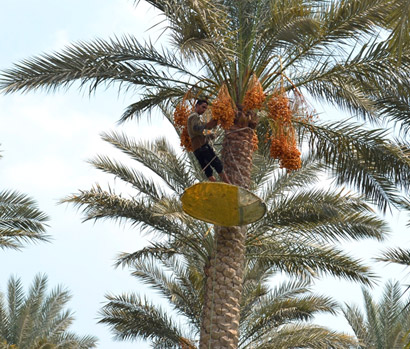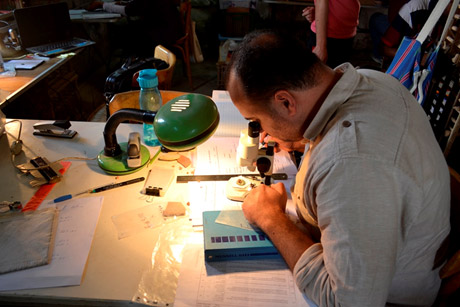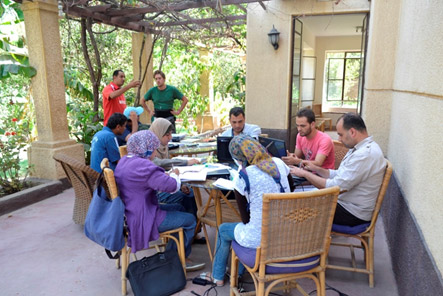We reached the end of the 2014 Mit Rahina field-school.
‘All too short’, is the unanimous feeling of the team. But we have managed to do a lot in only 4 weeks. Our aims were to train students in advanced ceramics analysis and archaeological illustration; and analyse certain categories of material – Old Kingdom ceramics, objects, mud sealings and ground stones.
Every morning we left the Giza Archaeological Centre soon after 6am, to drive to Memphis where we arrived to see the sun rise over the palm groves. We worked there until 1pm with a short break for breakfast at 10am. September-October is date harvest time at Memphis so often we had trays of different types of dates brought to us for tasting. Some prefer the bright yellow fibrous dates, others the dark brown soft dates, dripping with ’honey’. All washed down with strong tea made over a wood fire.

Simple tools for the date harvest – a belt to serve as a climbing harness, bare feet, a sharp knife, and a wide and shallow basket. Photo by Sayed Salah.
Back at Giza, after a late lunch, the afternoons were spent working in the library and on the computers. The illustrators digitally ‘inked’ their drawings; the ceramicists translated articles and researched comparative material for their reports. The students also downloaded the cameras, entered data on photo and ceramics databases, scanned and archived their work. There were lectures for the whole team, and the students prepared weekly reports and presentations.

Mahmoud el –Shafey analyses ceramic fabrics using the microscope and a Mussel colour chart. Photo Sayed Salah.
In the field the ceramics team, led by Mahmoud el-Shafey and Sherfi Abdel Moneim, analysed Old Kingdom pottery (c. 2686-2181 B.C.) from the excavation of the Middle Kingdom settlement (c. 2125-1773 B.C.) at Kom el-Fakhry in 2011. This pottery is ‘residual’ material – meaning earlier material which has been added later to mudbricks, or used as levelling deposits for construction, or mixed in refuse pits. Yet it provides a glimpse of the character of earlier deposits, part of the town, which remain unexcavated beneath, or near, the site.

Working al fresco -the ceramics and illustration groups work in the terrace of the Giza Archaeological Centre. Photo by Sayed Salah.
The illustration team led by Yasser Mahmdoud drew ceramics and objects ranging from small faience scarabs to very large grinding stones. Yasser also studied the mud-sealings, which are abundant. There are a few Old Kingdom sealings dated to Niuserre and Userkaf (again ‘residual’ material) and many design sealings characteristic of the Middle Kingdom. I recorded objects while Dr Giulio Lucarini did a preliminary analysis of ground stone tools. Dr David Jeffreys generously shared his in-depth knowledge of Memphis, in site tours, lectures, editing sessions, and chats over ‘iced café frappé’ (one of his specialities!). We compared results, in bi-weekly skype sessions, with colleagues working from home on site phasing, household cult objects, GIS and archives.
Some evenings we went into downtown Cairo for lectures. Even Fridays, the day-off, were put to good use with field trips to HeG and KKT sites at Giza. We also visited the important prehistoric site of Merimde Beni Salama in the Western Delta.

Rudeina Bayomi receives her MRFS 2014 graduation certificate from Dr Mamdouh el-Damaty, Minister of Antiquities. Photo by Sayed Salah.
And finally on Tuesday 30th of September, exactly 30 days after we opened the Mit Rahina field-school, the students received their graduation certificates from the Minister of Antiquities, Dr Mamdouh el-Damaty, in a ceremony held at the Zamalek office of the Ministry of Antiquities. We continued the celebrations with refreshments and cakes at the Giza Centre. Then students and supervisors travelled back to their inspectorates in Karnak, Qurna, Qena, Sohag and Saqqara. They will join their families for the Feast – Eid el-Adha, and a well-deserved rest…so we wish them perunefer – ‘good proceeding’ (or bon voyage).

A small group of very hard working students graduate from the MRFS 2014. Photo by Sayed Salah.
*Perunefer is also the name of the Memphis harbour in the 18th dynasty (New Kingdom).
